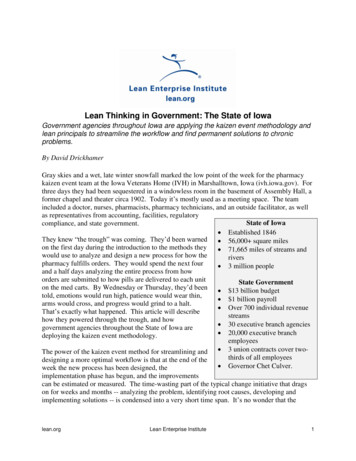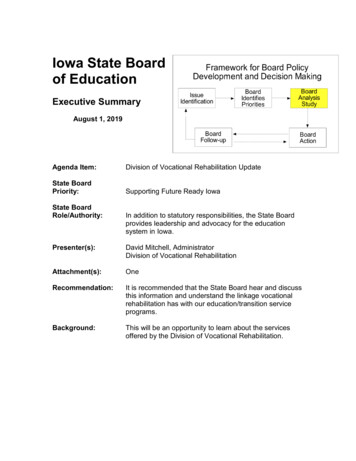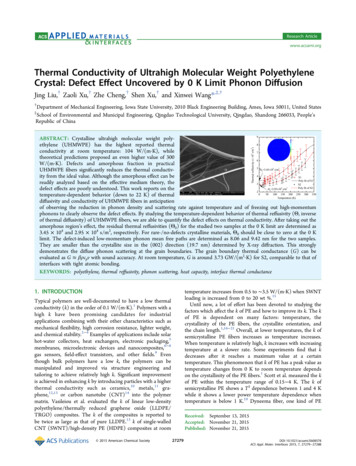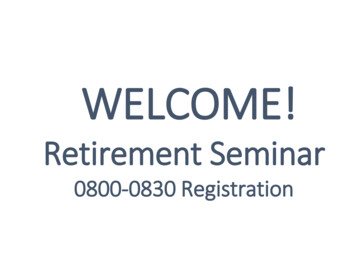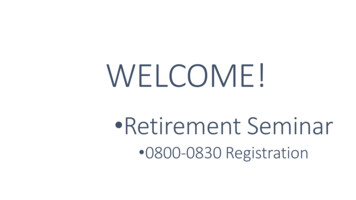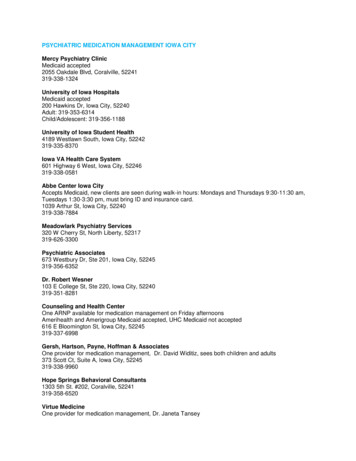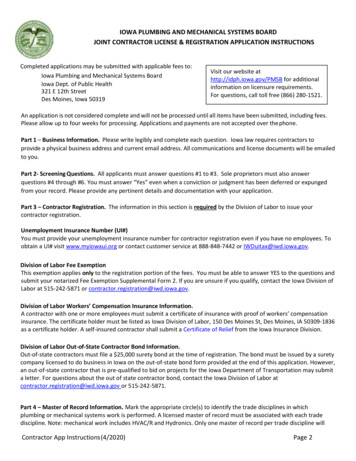
Transcription
ErgonomicsAn eBook Resource—Not a Course for Credit
Introduction to Ergonomics
Fast Facts Why have an ergonomics program? Protects workers Improves productivity Saves moneyAverage Cost per CTD Claim Before & After ErgonomicProgram ImplementationBeforeIn a report to Congress, theGeneral Accounting Officepresented case studies in whichcosts associated with cumulativetrauma disorders (CTD’s) weredramatically reduced whenergonomics programs rs ofCharityTexasInstruments
Repetitive Stress Injury What are the risk factors? Repetitive exertions Posture stresses Contact stresses Static exertions Forceful exertionsAreas likely toexperience and RSIGenerally: Pain indicates damage to muscles, tendons, or ligaments Numbness, tingling and loss of strength and/or coordination may indicate nerve damage Cold hands may indicate nerve and/or circulatory problems
Repetitive Stress Injuries Five main categories: Muscle May occur from chronic overuse or use of muscle groups not frequently used With rest symptoms resolve in a day or twoTendon Ligament Connect bone to bone-such as vertebrae- and can be damaged if improper lifting technique is used orother back problems occurCirculatory With overuse the tendon and sheath may become damaged and not operate properly-wont “glide” assmoothlyCan be impaired by vibration, repetitive motion, awkward postures, low temperatures, etc.Nerve Often occurs due to compression such as elbows resting on hard surfaces or sleeping on your arms
Repetitive Exertions In itself, repetition is not very risky, but when combined with other riskfactors such as high force and poor posture, repetition takes on increasedsignificance Includes activities such as: Assembly line work Typing Manual materials handling Laboratory procedures Etc.Repeating motions such astyping for assembly workwithout breaks can quickly leadto repetitive stress injuries
Posture Stresses If you experience posture stresses, habit modification and new equipmentare things to consider Includes things like: Awkward wrist bending Stooping Holding the phone between shoulder and ear Etc.
Contact Stresses Typically involves upper extremities and a hard surface Example: Typing or “mousing” on a square edge table-the underside of the arm is at risk ofa compression injury where the arm makes contact with the “sharp” edge of the deskConsider purchasing wrist rests for your keyboard and mouse-pad
Static Exertions A reduction in blood flow can take a toll on our soft tissues Examples: standing for long periods of time may cause pooling of blood in the legs, while keying atypist may find some muscles in the forearm that experience constant loading (contraction), etc. Be sure to take breaks and move or stretch all ofyour muscles to get blood flow moving fasterVibration and cold weather can also impedecirculation and lead to or worsen RSI’s Consider taking breaks when using things likepneumatic tools and wear warm clothing if you work in a cooler environment
Forceful Exertions The repetitive stress injury due to force increases as other risk factorscome into play RSI’s typically take months or years to develop and months or years toresolve When moving heavy objects-especially with poor physical conditioning and impropertechnique- tissue damage can occur immediatelyIf an object is too heavy orawkward to carry, ask for help!Risking the injury is not worth itIt’s importantto plan outhigh-demand tasks and to make gradual increasesin strength training routines
Carpal Tunnel Syndrome Often caused by the compression of the median nerve within the carpaltunnel Symptoms include: Tingling Burning Numbness Loss of coordination Muscle loss
Alternative Keyboards**Some material adopted from: “NIOSH Suggests Considerations for Alternative Keyboard Use”
Introduction The National Institute for Occupational Safety & Health (NIOSH) cautionsthat a computer keyboard is only one element of the workplace that caninfluence comfort and health Therefore, all features of the work environment should be examined when evaluating waysto enhance user comfort and avoid potential musculoskeletal problems Alternative keyboards can help keep wristsstraight and help to avoid postures thoughtto cause musculoskeletal problemsKeep in mind: It may take a few days to becomeaccustomed to an alternative keyboard and that somepeople never completely adapt to them
Quick Tips Broad-shouldered individuals may find that split keyboards allow improved(neutral) wrist postures compared to conventional keyboardsKeep in mind: Small individuals may find that greater width of ergonomic keyboards induces anuncomfortable distance and/or approach to the mouseTry to select a keyboard angle that promotes neutral (straight) wristposture Tilting akeyboard traywith anattachedmouse trapmay cause themouse to rolloff of the trayAt least one study has provided evidence that “negative slope” keyboards may helpalleviate keyboard discomfort and injury; although, to date there is no consensus on thissubject among ergonomists
Purchasing Suggestions Determine if the keyboard is compatible with existing hardware andsoftware and whether it can accommodate other input devices such as“mice” and trackballsDetails (a subsidiary of Steelcase, Inc.) is a govt.contract product line available to ISU departments. Findadditional information at: http://www.scdetails.com/ Assess how the keyboard will fit with the workstationSome ergonomic keyboards must be placed on surfaces that are lower than those required for standard keyboardsto achieve proper working posture If the workstation had a standard keyboard on a keyboardtray, an “ergonomic” keyboard may not fit on the old tray
Pointing Devices
Introduction Four main types:TrackballTouchpadMouse with “scroll” wheelSecond digit, Homo sapiens1.2.3.4.1.2.3.4.
Quick Tips It is important to place the device roughly adjacent to ( and roughly at thesame level as) the keyboard Some people find that switching hands and/or devices helps controlrepetitive stress injury symptoms If you are experiencing upper extremity pain or discomfort while at thecomputer, make a habit of moving your hands away from the mouse and/orkeyboard whenever possible Examples include when thinking, reading from the monitor, or while waiting for files todownload Stretching and/or massage may help alleviate symptoms
Low Back Pain
Snippets About 85% of Americans experience back trouble by age 50 Back problems are the most frequent cause of activity limitations inworking-age adults In the long run, surgery, chiropractic care, etc. , are considered no moreeffective than no treatment in reducing low back pain
The Spinal Column The human spinal column is the center of postural control It is built to provide stability and atthe same time allow flexibility These two seemingly incompatiblefunctions of support (inflexibility) andmovement (flexibility) are at oppositeends of the spectrum of movement, which is one reason the spine isso vulnerable to injury
Continued 7 cervical vertebrae (neck) 12 thoracic vertebrae (middle back) 5 lumbar vertebrae (low back) Sacrum (fused vertebrae) Coccyx (tailbone)Did you know? Two main forces acting on the spine:compressive (push discs together), and tensile (pullligaments, tendons, and muscles).Typically theseforces occur simultaneously, for example, whenlifting objects, or “slouching”.
The Spine – Disc Nutrition Located between the vertebrae in our backs are discs which act as theshock absorbers for the spine We feed our discs by moving fluids into and out of them throughmechanical compression and decompression One more reason to move about while at work
Acute Injury Risk Factors Acute (traumatic) back injury may occur due to: Slips, trips, fallsAuto accidentsSedentary lifestyle (with occasional lifting)Heavy and/or awkward loadsImproper lifting technique
Chronic Injury Risk Factors Chronic back injury may result from: Poor posture and/or improper lifting technique combined withrepetitive liftingGeneticsOverall physical fitness
Risk Reduction – Chronic Injury Maintaining a neutral spinal posture is important when seated as well asduring lifting tasks If sitting without back support: Rotate the hips forward until a neutral position is achievedIf using the backrest: Sit back in the chair to allow the backrest to help maintain aneutral posture and reduce muscle loading
Risk Reduction – Engineering/Design You can design a safer lifting environment by: Avoiding very high and very low object placement Reducing object weight and size Providing handles Eliminating the need for twisting motions Eliminating bending and stooped postures Providing mechanical assistance
Risk Reduction – Lifting Tips When lifting, you can substantially reduce your risk of low back injury andpain by: Keeping the object close to you Bending your knees Maintaining your lumbar curve (bend knees and stick buttocks out) Not twisting or bending sideways Avoiding rapid, jerky movements Asking for assistance with heavy and/or bulky loads
Risk Reduction – At Home Be sure to maintain neutral spinal posture when stooped For example, when shaving, brushing teeth, bathing children, repairing cars, shoveling,etc.Planning lifts and getting assistance or mechanical help whenever possible isalso a good risk reduction strategyNote: Avoid stoopingwhen gardening or doingother yard/maintenanceactivities
When to Seek Help For common back strain, give home remedies a try for 72 hours In rare cases, back pain can indicate a seriousproblem-seek medical attention if: You have weakness or numbness in either leg You have a fever along with back pain You notice new bladder or bowel control problems Your pain increases with lying down You have a history of significant chronic disease, such asosteoporosis, cancer, or diabetes
Medical Intervention Snippets Less than 5% of back pain is caused by serious disease (e.g. , cancer orinfection) or anatomical problems that require surgery Surgery is almost always elective, possiblyproviding faster relief of symptoms butmay have little effect on long termoutcomes Non-specific pain could originate withthe muscles, ligaments, facet joints, ordiscs and it is generally impossible to becertain of the exact causeNote: More often than not, simplyapplying an ice pack or heat pad tothe painful area and resting will“cure” back pain
Continued In a small fraction of cases, the pain willmove down the leg into the foot,usually as a result of a disc herniation Only about 25 of persons withback pain undergo surgeryMost herniated disc symptoms abate withoutsurgery and have been found surprisinglycommon even in non-symptomatic adults
Stretching & ExerciseStretching and exercise are oftenrecommended for back pain, however,some of these activities mayaggravate some conditions Some discomfort is considered acceptable during the activity, but shouldnot persist when the activity is discontinued
Back Belts The National Institute for Occupational Safety & Health has concludedthat: There is insufficient data to support back belt endorsement There is a potential for cardiovascular problems Back belts are not considered personal protective equipmentTo issue a back belt, ISU requires: Job analysis Medical recommendation Fitting Employee training
Resources Mayo Clinic http://www.mayohealth.org/ Click on “search” and type “back pain”Check out these websites orcontact EH&S to get moreinformation!Herman-Miller http://www.hermanmiller.com/research/ Click on “ergonomics” and look for information on seating and back painNIOSH http://www.cdc.gov/niosh/homepage.html Click “topic index” then chose “ergonomics” or use the “search” function and type “backpain”
Features to Consider whenPurchasing a Chair
Introduction Perhaps you find your chair is not particularly comfortable and seems tobecome less so each time you plop down upon it This guide is designed to help you identify chair features that will makeyour seated work more comfortable and productive
Adjustment Options There are numerous seat adjustment options including: Seat height Backrest height Armrest height Armrest width Backrest tilt Variable backrest stop Backrest tension Seat pan depth Foot ring height
Quick Tips Seat height in most chairs is adjustable; if you are larger or smaller thanaverage, the height range of an “average” chair might not be adequate-checkwith the manufacturer to make sure the chair you select is available in yoursize and is easily adjustable Be sure to select a chair that offersbackrest height adjustment, maintaininga “neutral” lumbar (lower back) curveand having that extra support is important Some chairs have a seat pan tilt option By lowering the front of the seat pan, the lumbar spine assumes a posture closer to theneutral standing posture which reduces pressure on the lumbar spine
Continued If possible, select a chair that will have an upright locking mechanism, areclining backrest, and backrest tension adjustment When writing or typing, many workers prefer to sit upright; however, then speaking to coworkers, reclining is recommended as it reduces pressure on the lower backTry to find a seat pan that is fitted to your body A seat pan that is too short results in increased pressure on the buttocks and thighs A seat pan that is too deep can restrict circulation at the knee and makes it difficult toattain proper lumbar support Generally, a sliding seat pan will provide comfortable seating for a wide range of individualsFive-star chair bases are safer than four-star bases - especially ifyou like to lean back in your chair.Fortunately, chair manufacturers have recognized this fact andfour-star bases are now pretty much a thing of the past.
Just A Thought Chairs set on linoleum tile or cement flooring should have soft rubbercasters To keep you from zooming around too fastChairs in carpeted areas should have hard plastic casters To keep you from getting bogged downZooming aroundLinoleum flooring
Small Budget? If your seat pan is too deep, try purchasing a seat back cushion If your armrests are too short, consider attaching foam to the top of them Many small changes can make a big differenceBe sure you know your chairadjustments-and use them!
Computer WorkstationErgonomics Checklist
Introduction This checklist is designed to guide you through an ergonomic assessmentof your computer workstation If you answer “NO” to an item, it may indicate a need for workstationmodification If you have any questions, comments, concerns, or need further informationplease contact EH&S at (515).294.5359
Chair Adjustment Primary considerations: Is your chair height adjustable? Does your chair support your lower back? Is there room between the front edge ofthe chair seat and the back of your knees? Can you easily reach your work withoutinterference from the arms of your chair? When using the keyboard or mouse, areyou able to keep your arms in a comfortable position with elbows at your sides? Do your feel rest flat on the floor or footrest? When you sit upright in your chair, are your thighs approximately parallel to the floor? Does your chair have an upright locking feature?
Other Considerations Adopting two or more seated postures will allow various muscle groupstime to relax and recover If your chair backrest is adjustable,raise or lower it so that the contourof the chair provides maximum lowerback support If your chair has armrests, theyshould allow you to get close to your work If you’re typing, they should be at a height where they barely contact your elbows whenyour arms are resting comfortably at your side Chair armrests should not force you to elevate your shoulders or wing your arms to theside
The Ergonomist’s Opinion Sitting with several “bad” postures for shorterperiods of time may be better (or at least noworse) than using one “good” posture overlong periods of time Individuals are encouraged to use 3 or moreseated postures throughout the workday to allow various musclegroups time to relax and recuperate. Recommended postures include:1.2.3.4.“perched” on the edge of the chair – with pelvic tilt to maintain good low backcurvatureUpright with seat back locked and the gluteus maximus all the way to the back ofthe seatReclinedOther postures you feel comfortable with
Keyboard Adjustment Primary considerations: With your chair adjusted properly, are your keyboard and mouse approximately at elbowheight? Are your arms in near your trunk rather than stretched out in from of you? Is there at least an inch of clearance between the bottom of your work surface and thetop of your thighs?Elbow heightArms in near trunk1 inch of clearance(at least)
Other Considerations If your keying surface is too high (or too low) and cannot be changed, installingan adjustable keyboard tray may be a solution If your keying surface is too high and akeyboard tray is not feasible, raise the chairand support your feet with a footrest ifnecessary Another approach is to elevate the backedge of the keyboard until your hands andforearms for a straight or somewhat straight line when fingers are on the keys If your keying surface is too low and cannot be adjusted, try elevating theleading edge of the keyboard until your hands and forearms form a straight orsomewhat straight line when fingers are on the keys
The Ergonomist’s Opinion Your forearms do not need to be exactlyparallel to the floor while at the keyboardIf your hands are more than one or two inches higher or lowerthan your elbows, changing your workstation configuration mayreduce your risk of cumulative trauma disorderDid you know? Resting hands on a wrist rest orin your lap when not actively keying isrecommended; however, using a wrist rest thatinduces poor (bent) wrist posture may induceinjury Footrests are best left as an option of last resort Their use will tend to constrain the worker when it is actually postural fluidity we areseeking Many workers have two or three seating locations withinthe workstation - meaning two or three footrests may beoptimal for a given employee
Work Surface Primary considerations: Does your writing surface have a rounded leading edge? When seated upright, is the work surface height approximately midway between yournavel (belly button) and the bottom of your sternum (breastbone)?Naval height
Other Considerations Many of the work surfaces (desks) on theISU campus are Steelcase 9000 series These surfaces have four height options:29.75”, 28.75”, 27.25” and 26.25” What’s average? Many men of average stature will find the 29.75”height acceptable Women of average stature will likely be mostcomfortable reading and writing at 28.75” or 27.25”Note: Some smallerpersons prefer a worksurface height of 26.25”,this may require switchingto smaller hanging filepedestals (drawers)
The Ergonomist’s Opinion It’s best to key (whether at a keyboard or with a calculator) and write atseparate heights If separate surfaces are not practical (forcing you to key and write at oneheight), selecting an intermediate height may be acceptable in some casesWrite hereKey here
Monitor Adjustments Primary considerations: Is your monitor more-or-less in front of your keyboard rather than off to the side?Is the viewing distance to your computermonitor at least 18 inches?Is the top of the computer screen beloweye level?Is your computer monitor protected fromexcess glare?Is your monitor screen more-or-lessperpendicular to your normal line-of-sight?If you wear bifocals or trifocals, are youable to look at the monitor without tiltingyour head backwards?
Other ConsiderationsIf you feel as though your monitor is tooclose but you cannot “get away” from it, installa keyboard tray and/or pull the desk out fromthe wall - letting the monitor “hang” overthe back of the work surface Note: Check out the e-book on eyestrainfor some helpful suggestions and moreinformation about monitor placement andscreen related eyestrain prevention
The Ergonomist’s Opinion Keeping the monitor on the work surface (as opposed to resting on acomputer CPU) is recommended unless the new placement/angle createsunwanted screen glare E.g., from overhead lighting Be sure to readjust the monitor tilt after adjusting the monitor height
Workstation Accessories Primary considerations: Are your primary work materials located in front of you? Are your most frequently accessed items (phone, manuals, etc.) easy to reach? Do you have a document or copy holder to hold reference materials? If a large percentage of your time involves using a phone, do you use a phone headset?
Other Considerations As you change tasks, remember to move primary materials in front of you When reading or writing on the desk, inclining the material by placing it ona 3-ring binder or other material will improve neck and back postureThree-ring binder!
The Ergonomist’s Opinion It’s okay to place items where they aremost comfortable to reach - ratherthan where they look “best”Remember! Be sure tohave a “method to themadness” and knowwhere everything is!In some cases, a slant board may be a better option than a copyholder asthelatter allows inclined viewing of large, heavy materials such as books and ringbinders
Work Habits Primary considerations: Do you move your hands away from the keyboard and/or mouse as work allows (e.g.,when waiting for files to download, reading text, or thinking about what to write)? When at the computer, do you take short, frequent breaks (up to a minute every 10-15minutes) vs. less frequent breaks? Do you avoid end-of-year or end-of-cycle “crunches” by starting work sooner, gettingassistance, or via other means?
Other Considerations If you are experiencing pain or discomfort at work and anticipate anincrease in workload, be sure to speak to your supervisor about yourconcerns and have your workstation evaluated promptly Often it’s helpful to ask an outsider to perform an ergonomic evaluationbecause they do not share your assumptions about work routines andenvironmentsEH&S will gladly perform ergonomic evaluations!Contact us at (515).294.5359 orEnvironmental Health and Safety, Iowa State UniversityRemember! Get yourworkspace evaluated before youget to this stage
The Ergonomist’s Opinion If you are assessing your workplace for ergonomic risk factors andsolutions, it’s a good idea to pretend that anything is possible and thatmoney is no object Once potential solutions are identified, assumptions about work routines,budgets, etc., can be discussedDiscuss money andoptions with your teamand supervisors beforetaking action
Stretching at Work
Reasons to Stretch at Work Reduce muscle tension and stress Increase alertness and productivity Improve circulation It makes you feel better!
Things To Do When Stretching Be excited! You’llget more energyout of yourstretch! Make slow movementsHold the stretch for at least 5seconds (10 is recommended)Experiment with slight variations in posture andmovement to improve stretch effectiveness Stretch frequently, especially when sittingor in other constrained environments
Things To Avoid When Stretching Rapid Movement Holding your breath Bouncing PainNote: Stretching mayaggravate certain medicalconditions (e.g., herniateddisc)-be sure to talk to amedical professional prior tostarting your stretchingprogram
The Finger Stretch Start with your fingers relaxed Curl and tense fingers Stretch fingers out and apart Repeat cycle
The Wrist Rotation Clasp your hands together Rotate your right hand over your left hand Rotate your left hand over your right hand Repeat cycleBe sure to rotate bothdirections for a completestretch!
The “Handshake” Stand upright Hold your hands at your sides and relax your shoulders/arms Shake your hands lightly but rapidly
The Wrist Flex Start from a typical seated posture Extend both arms with palms facing the wall aheadof you Place your left hand on your right hand fingers andpull towards the wall behind you Repeat on each hand
The Overhead Stretch Start from a typical seated posture Clasp your fingers together Move your hands upward, towards the ceiling, while rotating your palmsoutwards
The Neck/Shoulder Stretch Start with your shoulders in a neutral position Relax your arms and shoulders Tense the muscles in your lower neck and shoulders, “raising yourshoulders to your ears” Hold for 5-10 seconds and relax to original position
The Shoulder Stretch Start with your shoulders relaxed Raise your left arm and place your right hand on your left elbow Use your right hand to pull your left elbow toward your right shoulder Repeat cycle on each arm
The (other) Shoulder Stretch Start with your shoulders relaxed Raise your right arm and reach withyour right hand for your left shoulderblade Use your left hand to press on yourright elbow toward your left shoulder Repeat cycle on each arm
The Upper-Back Stretch Face an open doorway with your toes 1-2 feet from the opening Place your hands on either side of the door frame at about shoulder height Slowly lean forward, into the open doorway, keeping your hands on eitherside of the opening
The “Executive” Start in a typical seated, working position Clasp your fingers behind your head, resting your hands on the back ofyour head Lean back and press your elbows backwards, lifting the shoulders and chestslightly Repeat as desired
The Neck Roll Sit or stand in an upright position Slowly tilt neck to one side Slowly tilt neck to the other side Tilt head forward, and then back
The Calf Stretch Take a staggered stance with your left foot about 1 foot away from a walland your left foot about 3 feet from the same wall Place your hands on the wall or chair at about shoulder height Bend your right knee and lean forward into the wall keeping your left footflat Repeat on each leg
The Hamstring Stretch Grab hold of a chair, desk, or other object for balanceStand with your feet about 3-4 feet apart with your toes turned slightlyoutwardBend at your hips toward your right leg, reaching for your calfRepeat on left legFeel the stretch!
The “Flamingo” Stretch Grab hold of a chair, desk, or other object for balance Raise your left leg, grabbing your left anklewith your left hand Gently and slowly, press your left (bent) kneetowards the “back” of the room while slightlypulling your left ankle towards the “front” ofthe room Repeat on each leg
Remember! EH&S staff are available to perform ergonomic evaluations for ISUpersonnel Call (515).294.5359 for details OR find us on FacebookEnvironmental Health and Safety, Iowa State University
Finish
Static Exertions A reduction in blood flow can take a toll on our soft tissues Examples: standing for long periods of time may cause pooling of blood in the legs, while keying a typist may find some muscles in the forearm that experience constant loading (contraction), etc. Be sure to take breaks and move or stretch all of your

